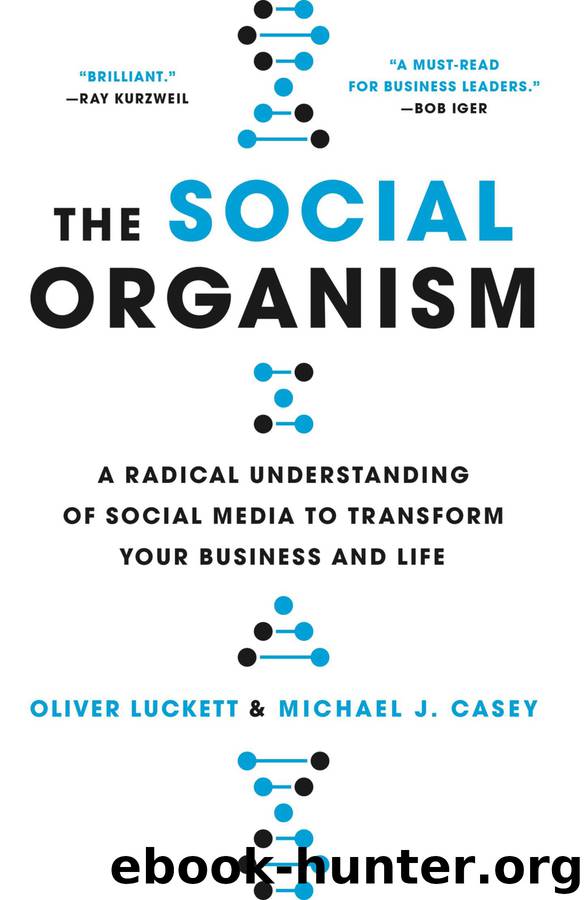The Social Organism by Oliver Luckett & Michael J. Casey

Author:Oliver Luckett & Michael J. Casey
Language: eng
Format: epub, mobi
Tags: Business & Economics / Industries / Computers & Information Technology, Computers / Web / Social Networking, Social Science / Media Studies
Publisher: Hachette Books
Published: 2016-11-14T16:00:00+00:00
As we’ve discussed, it takes more than simply pushing a message out to a broad number of influencers to make it grow. To harness the Social Organism’s global distribution system for maximum impact, the message must possess the right content, too. We know from history that artworks that become powerful memes are those that tap into deep-seated emotions: the uplifting celebration in Beethoven’s “Ode to Joy”; the rousing “I have a dream” speeches of Martin Luther King Jr.; the patriotic stirrings that Americans found in the Iwo Jima flag-raising image; or the resolute determination that Alberto Korda’s portrait of Che Guevara inspired in generations of would-be revolutionaries. Now in the social media era, the ability to stir up emotion is as important as ever to the success of any piece of content.
Remember the Wharton business school study of the differing impact that a variety of emotional triggers would have on people’s propensity to share news stories on social media? It showed that our responses to a piece of online content will fluctuate depending on the type of emotion that it elicits. The researchers showed that the response was determined first by a binary question of the feeling generated—whether it was emotionally positive or negative—and second by a more nuanced matter of whether the particular emotion elicited was more or less likely to motivate action. But there’s a third way to break this down: What kind of a response do we want to generate? Just because an image or a piece of text is shared doesn’t mean the memetic replication will automatically confirm to the positive image, persona, or brand management we intend to cultivate. We might think we’re “performing” certain desirable versions of ourselves, but there’s no guarantee the audience will see it that way. Their responses to our performance, the choices they make in how to portray it, can do as much to determine the public persona that emerges out of this interaction as we can. A social media audience in this sense also composed of cast members engaged in the performance of “you.”
Let’s return to the biological analogy. If we examine different types of emotion-inducing content as a biologist might study the impact of consuming different sources of nutrition, we can think of the various types of published messages as food types. Each will have unique, distinct effects on the Social Organism’s well-being. What the Organism’s metabolism needs, I like to say, is a balanced diet. So while a message with an angry tone, with its capacity for adrenaline release, might be an especially strong motivator for someone to hit the retweet button, it’s not a healthy source of sustenance over the long term. It breeds negativity on a wider scale, which as the Wharton study suggests, would, over the longer term, tend toward the contradictory impact of lessening people’s desire to share content. Much like Big Macs, anger releases endorphins that give a transitory sense of satisfaction. But most of us know we should limit our consumption of cheeseburgers.
Download
The Social Organism by Oliver Luckett & Michael J. Casey.mobi
This site does not store any files on its server. We only index and link to content provided by other sites. Please contact the content providers to delete copyright contents if any and email us, we'll remove relevant links or contents immediately.
Cecilia; Or, Memoirs of an Heiress — Volume 1 by Fanny Burney(32434)
Cecilia; Or, Memoirs of an Heiress — Volume 2 by Fanny Burney(31868)
Cecilia; Or, Memoirs of an Heiress — Volume 3 by Fanny Burney(31852)
The Great Music City by Andrea Baker(31327)
We're Going to Need More Wine by Gabrielle Union(18967)
All the Missing Girls by Megan Miranda(15562)
Pimp by Iceberg Slim(14379)
Bombshells: Glamour Girls of a Lifetime by Sullivan Steve(13972)
Talking to Strangers by Malcolm Gladwell(13222)
Norse Mythology by Gaiman Neil(13204)
Fifty Shades Freed by E L James(13157)
For the Love of Europe by Rick Steves(12927)
Mindhunter: Inside the FBI's Elite Serial Crime Unit by John E. Douglas & Mark Olshaker(9186)
Crazy Rich Asians by Kevin Kwan(9166)
The Lost Art of Listening by Michael P. Nichols(7403)
Enlightenment Now: The Case for Reason, Science, Humanism, and Progress by Steven Pinker(7228)
The Four Agreements by Don Miguel Ruiz(6622)
Bad Blood by John Carreyrou(6543)
Weapons of Math Destruction by Cathy O'Neil(6142)
